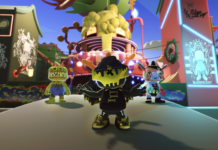When Nintendo released The Legend of Zelda: Ocarina of Time in 1996, they never thought it would be deemed one of the best games ever made. Yet this ground-breaking title is exactly that: a perfectly developed game with a brain-teasing series of dungeons, a compelling storyline, memorable music, and a distinctly Nintendo charm. When Nintendo announced Ocarina of Time 3D at E3 2010, anticipation for the unprecedented remake skyrocketed. With fresh graphics and new 3D effects, this may very well be the system seller that the 3DS needs.
It’s been well publicized that Ocarina of Time 3D (launching June 19) is going to look much better than the N64 original. For anyone who doesn’t remember, the N64 had a tendency to make games look muddy, with awful textures smeared across walls and floors (our Nintendo representative said it himself). This 3DS update solves the problem with crystal clear image processing. Hyrule field is properly huge, with greatly drawn distances, and the fog of Kokiri forest is much less pronounced, used only because, well, it needs the mystery.

All of the textures have been redone. Nintendo conveniently had a copy of Ocarina of Time running in 480i on a TV, and the differences between the original and the remake are startling. We were shown four areas: the Deku Tree temple, the Hyrule overworld, Hyrule Castle Town, and Jabu Jabu’s Belly. Each of these areas plays exactly like the original; however, they all look much better in quality.
The Deku Tree originally had textures that looked like green and brown finger paint. The floors and walls inside this tree are now much crisper and cleaner, with brighter and more vibrant greens. Jabu Jabu’s Belly has been modified to look much more organic and fleshy. It feels much more like Link is adventuring through the belly of a giant fish. The most radically changed area is Hyrule’s Castle Town, no longer a muddy smear of pre-rendered buildings. Each of the buildings is much brighter and more colorful, and fans comparing the 3DS version to the N64 original will be surprised at how much the visuals have improved. Additionally, the Temple of Time no longer has an infinite ceiling of black, but now an actual roof and chandelier situated above Link as he passes through time.

The biggest change is to the character models. Nintendo representatives said that the goal of developer Grezzo is to make the characters and locations resemble the concept art seen on promotional materials for the original game. Link looks worlds better now than he did before, and so do the NPCs.
This polished Ocarina of Time incorporates the 3D effect quite nicely. Unlike other 3DS games, 3D can be cranked up to the maximum power without feeling or looking off. Some of the effects, such as a rotating Triforce or Queen Gohma sticking her eye out, are very impressive. Overall, this may be one game that pushes the boundaries of the 3DS hardware.

On the bottom screen, what initially looks very cluttered is actually a very streamlined version of Zelda. Instead of using different sub-menus, items can be hot keyed to the X and Y button as well as two soft-buttons on the screen. We recommend linking those soft buttons to items like deku seeds and bottles, as the X and Y are better suited to the boomerang, slingshot, and the bow and arrows. The ocarina has a dedicated button on the touch screen and can be performed either with buttons pressed from a combination of L, R, X, Y, and A or tapped out with the touchscreen. The song patterns can be kept on screen while playing, as well. A map easily rates as the most important element of this lower screen.
A streamlined Ocarina of Time means the game is much faster to play. Without having to press pause every few moments, players can do much of their inventory management as they go along. The Water Temple will greatly benefit from the bottom screen’s innovation, supposedly.

There’s more to the remake than a visual upgrade. At the moment, Ocarina of Time 3D uses the accelerometer to control shooting with the slingshot (and presumably the boomerang and bow). Players can also control with the circle pad, but the accelerometer actually controls fantastically. We found it much easier to shoot by orienting ourselves physically. For some reason, this method is one of the most intuitive we’ve seen with motion control, and Nintendo representatives said that reverting to the original controls of the N64 version is very difficult.
Unfortunately, for all that the 3DS has to offer, a couple of things are missing. Since the 3DS doesn’t support rumble, don’t expect the hidden item finding Stone of Agony to work exactly the same. Also, while the game has seen a major visual overhaul, the audio remains untouched. Some orchestration would be appreciated.

Also, we’re disappointed that players can’t jump immediately into Master Quest. As the long lost remix of the dungeons of Ocarina of Time, the Master Quest was last playable in the freebie Gamecube disc for those who preordered Wind Waker. It’s back now, but gamers will have to wait to unlock it after their initial playthrough.
I’ve had many opportunities to play Ocarina of Time during conventions throughout the year, but it never seemed like something necessary to play. After all, it’s a remake. Yet after substantial time with this game, Ocarina of Time has proven to be one of the best-looking and most playable 3DS games coming to the market. June 19 can’t come soon enough.










